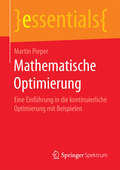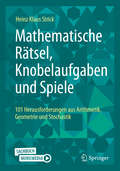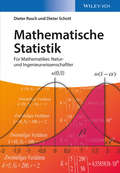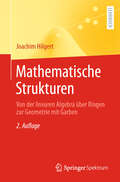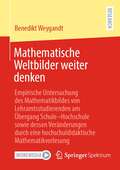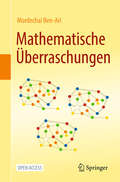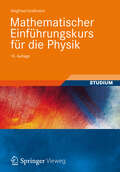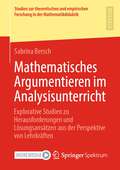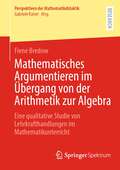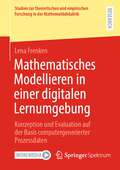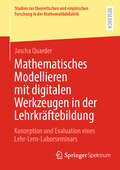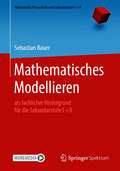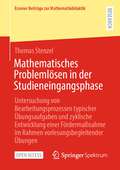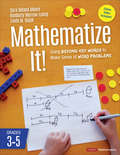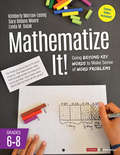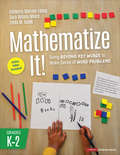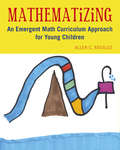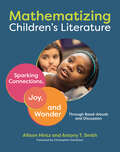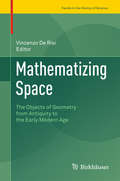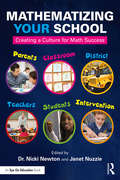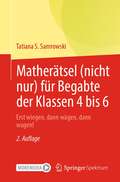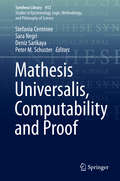- Table View
- List View
Mathematische Optimierung: Eine Einführung in die kontinuierliche Optimierung mit Beispielen (essentials)
by Martin PieperDas essential gibt Bachelor- und Masterstudierenden der Ingenieur- und Naturwissenschaften sowie der Wirtschaftswissenschaften eine kurze, anschauliche Einf#65533;hrung in die mathematische Optimierung. Anhand zahlreicher Beispiele werden die Grundbegriffe und Kernaussagen der kontinuierlichen Optimierung erl#65533;utert und angewendet. Es werden sowohl Optimierungsprobleme mit und ohne Nebenbedingungen als auch mehrkriterielle Probleme mit mehr als einer Zielfunktion behandelt.
Mathematische Rätsel, Knobelaufgaben und Spiele: 101 Herausforderungen aus Arithmetik, Geometrie und Stochastik
by Heinz Klaus StrickDieses Buch richtet sich an alle, die Freude haben am Lösen mathematischer Probleme und die etwas Geduld und Ausdauer dafür mitbringen. Es ist sehr vielseitig einsetzbar – in der Freizeit, im Schulunterricht, im Rahmen der Begabtenförderung und in AGs. Die überwiegend mehrschrittigen Aufgaben können unabhängig voneinander bearbeitet werden. Die bunte Mischung macht Lust darauf, einfach „loszulegen“: Zugänge finden, Ideen entwickeln und Lösungsansätze ausprobieren. Konkret geht es beispielsweise um Fragen wie: Wie können LEGO-Mauern stabil gebaut werden? Welche falsch gekürzten Brüche sind trotzdem richtig? Wieso können quadratische Gleichungen auch mehr als zwei Lösungen haben? Wie passen regelmäßige Vielecke ineinander? Wie findet man faire Regeln für Würfelspiele? Die Aufgaben im ersten Teil sind mit elementaren mathematischen Methoden lösbar, also bereits für Grundschule und Unterstufe geeignet. Für die Probleme des zweiten Teils werden Kenntnisse der Mittelstufe vorausgesetzt, für die des dritten Teils teilweise auch Methoden, die erst in der Oberstufe vermittelt werden. An manchen Fragestellungen des vierten Teils dürften selbst erfahrene Mathematiker zu knobeln haben. Daher werden ausführliche Lösungen sowie Hinweise auf alternative Lösungswege bereitgestellt – sie machen etwa drei Viertel des Buchumfangs aus. Für einige Aufgaben sind außerdem Kopiervorlagen online abrufbar.
Mathematische Statistik
by Dieter Rasch Dieter Schott"Mathematische Statistik" hat wegen des großen Anwendungsbedarfes stetig an Attraktivität gewonnen - und auch theoretisch sind neue Ansätze entwickelt worden. Ein besonderer Schwerpunkt liegt auf der Versuchsplanung, die häufig gegenüber der Auswertung vernachlässigt wird. Unter konsequenter Berücksichtigung der Entwicklungen der letzten Jahrzehnte ist ein neues Buch entstanden. Kenntnisse in der Maßtheorie und der Wahrscheinlichkeitsrechnung sind hilfreich, aber nicht notwendig, da die Autoren die Materie leicht verständlich beschrieben haben. Ein Schwerpunkt liegt auf der Versuchsplanung, die zu oft vernachlässigt wird und oft neben der Auswertung benachteiligt ist. Konsequenterweise nimmt in diesem Buch die Planung des Stichprobenumfangs und die Beschreibung von Versuchsanlagen einen großen Raum ein - immer eingebettet in die passenden Auswertungsverfahren wie die Varianz- und Regressionsanalyse. Ein Muss für alle Natur- und Ingenieurwissenschaftler, die empirisch arbeiten und daneben auch an der Begründung der Methoden interessiert sind.
Mathematische Strukturen: Von der linearen Algebra über Ringen zur Geometrie mit Garben
by Joachim HilgertDieses Buch richtet sich an Studierende der Mathematik, die die Anfängervorlesungen in Analysis und Linearer Algebra gemeistert haben. Es ist gedacht als Orientierungshilfe für die Vielzahl an spezialisierten Fachveranstaltungen in den mittleren und höheren Semestern. Ein wichtiges Anliegen ist die Darstellung von Vergleichsmöglichkeiten und Ähnlichkeiten zwischen mathematischen Disziplinen. Das organisierende Prinzip ist der Begriff der mathematischen Struktur, der sich durch alle Teilgebiete der Mathematik zieht. Die Inhalte, an denen die verschiedenen Typen von Strukturen exemplarisch erläutert werden, decken curriculare Anforderungen insbesondere aus der Algebra und der Geometrie (differentiell und algebraisch) ab. Die Diskussion von Vergleichsmöglichkeiten enthält aber auch Einführungen in die Kategorientheorie und die Garbentheorie, deren Bedeutung in der modernen Mathematik eine stärkere Verankerung in den Curricula nahelegt. Das Buch eignet sichinsbesondere auch zum Nachschlagen der dargestellten Strukturen.Die vorliegende 2. Auflage ist vollständig durchgesehen und um ein Kapitel zu Mannigfaltigkeiten mit Strukturen wie komplex, symplektisch, affin etc. erweitert.
Mathematische Weltbilder weiter denken: Empirische Untersuchung des Mathematikbildes von Lehramtsstudierenden am Übergang Schule–Hochschule sowie dessen Veränderungen durch eine hochschuldidaktische Mathematikvorlesung
by Benedikt WeygandtIn dieser Studie wird untersucht, mit welchem schulisch geprägten Mathematikbild Studierende an die Universität kommen und wie sich dieses durch die Begegnung mit der universitären Mathematik verändert. Zugleich wird die Wirksamkeit einer neu konzipierten hochschulmathematikdidaktischen Vorlesung auf die mathematischen Weltbilder der Lehramtsstudierenden untersucht. Mathematische Weltbilder weiter zu denken ist hierfür gleichermaßen Anspruch wie Aufforderung: Mithilfe der entwickelten Skalen ist eine breitere Erfassung von Einstellungen gegenüber Mathematik möglich, sodass diese nun weiter gedacht werden können als zuvor. Es wird gezeigt, dass sich Einstellungen zur Mathematik durch entsprechend gestaltete, fachmathematische Lehrveranstaltungen gezielt adressieren lassen. Dies ermöglicht es, die Lehramtsausbildung mit Blick auf die Zukunft weiterzudenken: Lehrkräfte sind gesellschaftliche Botschafter*innen für Mathematik und müssen über ein tragfähiges und facettenreiches Mathematikbild verfügen, um in einem modernen, kompetenzorientierten Unterricht die Relevanz der Mathematik und ihre Bedeutung als Kulturgut und Schlüsseltechnologie vermitteln zu können.
Mathematische Überraschungen
by Mordechai Ben-AriDieses Buch ist Open-Access und bietet viele mathematische Überraschungen. Es gibt viele faszinierende Ergebnisse, die nicht in Lehrbüchern erscheinen, obwohl sie mit guten Kenntnissen der Sekundarschulmathematik zugänglich sind. Dieses Buch stellt eine Auswahl dieser Ergebnisse vor, darunter die mathematische Formalisierung von Origami, Konstruktionen mit Lineal und Zirkel (und anderen Instrumenten), die Fünf- und Sechs-Farben-Theoreme, eine Kostprobe der Ramsey-Theorie und wenig bekannte Theoreme, die durch mathematische Induktion bewiesen werden. Zu den überraschendsten Theoremen gehören das Mohr-Mascheroni-Theorem, das besagt, dass alle klassischen Konstruktionen die mit Lineal und Zirkel ausgeführt werden können, tatsächlich sogar nur mit einem Zirkel ausgeführt werden können, und das Steinersche Theorem, das besagt, dass ein Lineal allein ausreicht, wenn ein einziger Kreis gegeben ist. Der Höhepunkt des Buches ist eine detaillierte Darstellung des rein algebraischen Beweises von Gauß, dass ein regelmäßiges Heptadekagon (ein regelmäßiges Polygon mit siebzehn Seiten) mit Lineal und Zirkel konstruiert werden kann. Obwohl die in diesem Buch verwendete Mathematik elementar ist (euklidische und analytische Geometrie, Algebra, Trigonometrie), werden Schüler und Studenten an weiterführenden Schulen und Hochschulen, Lehrer und andere interessierte Leser gerne die Gelegenheit nutzen, sich der Herausforderung zu stellen, diese überraschenden Theoreme zu verstehen.
Mathematischer Einführungskurs für die Physik
by Siegfried GroßmannStudierende, die ein Physikstudium aufnehmen, brauchen zu Beginn vor allem eines: mathematische Grundkenntnisse. Da es sich hierbei zunächst um einen relativ beschränkten und charakteristischen Ausschnitt aus der Mathematik handelt, werden die benötigten Kompetenzen vor allem im Rahmen von Tutorien oder Arbeitsgruppen vermittelt. Dieser Einführungskurs soll Studierenden im ersten Semester helfen, die Inhalte dieser Veranstaltungen zu vertiefen und möglichst rechtzeitig die Fähigkeiten zu erwerben, die ein erfolgreiches Physikstudium garantieren.
Mathematisches Argumentieren im Analysisunterricht: Explorative Studien zu Herausforderungen und Lösungsansätzen aus der Perspektive von Lehrkräften (Studien zur theoretischen und empirischen Forschung in der Mathematikdidaktik)
by Sabrina BerschSabrina Bersch untersucht in zwei aufeinander aufbauenden qualitativen Studien das mathematische Argumentieren im Analysisunterricht aus der Perspektive von Lehrkräften. Zunächst werden die Begriffe Argumentieren, Begründen und Beweisen geklärt und in einem Modell zueinander in Beziehung gesetzt. Das mathematische Argumentieren wird dabei im weiten Sinne als Oberbegriff verstanden. Die erste Interviewstudie thematisiert unter anderem die aktuelle Situation des mathematischen Argumentierens im Analysisunterricht. Es zeigt sich insbesondere, dass die Heterogenität von Lerngruppen sowie sprachliche Schwierigkeiten von Schülerinnen und Schülern zentrale Herausforderungen für Lehrkräfte sind. Als Reaktion darauf werden weitere theoretische Grundlagen geklärt und eine differenzierende, aufgabenbasierte Lernumgebung mit sprachförderlichen Elementen zum Argumentieren mit ganzrationalen Funktionen ausgearbeitet. Hierfür werden verschiedene Aufgaben, Lösungsbeispiele und Formulierungshilfen entwickelt. Der unterrichtliche Einsatz dieser Lernumgebung durch Lehrkräfte wird mit einer anschließenden, zweiten Studie evaluiert.
Mathematisches Argumentieren im Übergang von der Arithmetik zur Algebra: Eine qualitative Studie von Lehrkrafthandlungen im Mathematikunterricht (Perspektiven der Mathematikdidaktik)
by Fiene BredowArgumentieren ist wichtig für das Lernen von Mathematik. Lehrkräfte tragen entscheidend dazu bei, ob und wie Argumentationen im Mathematikunterricht gelingen. Welche Rolle die Lehrkraft beim mathematischen Argumentieren im Übergang von der Arithmetik zur Algebra spielt, arbeitet Fiene Bredow in dieser Studie heraus. Dazu werden Unterrichtssituationen im Übergang von der Arithmetik zur Algebra erhoben und die stattfindenden Argumentationsprozesse und die hervorgebrachten mathematischen Argumente mit einem Fokus auf die Lehrkraft analysiert. Angelehnt an Conner et al. (2014) werden Unterstützungshandlungen von Lehrkräften kodiert und weitere Lehrkrafthandlungen induktiv rekonstruiert. Ein Kategoriensystem zu Lehrkrafthandlungen bei Argumentationen im Mathematikunterricht wird entwickelt. Als ein entscheidender fachlicher Aspekt im Übergang von der Arithmetik zur Algebra wird die Prozess-Produkt Dualität von mathematischen Objekten beim Argumentieren betrachtet und herausgearbeitet, wie Lehrkräfte die Deutungen ihrer Schüler:innen adressieren. Diese Studie zeigt, dass mathematische Argumentationsprozesse vielschichtig, komplex und auch fragil sind.
Mathematisches Modellieren in einer digitalen Lernumgebung: Konzeption und Evaluation auf der Basis computergenerierter Prozessdaten (Studien zur theoretischen und empirischen Forschung in der Mathematikdidaktik)
by Lena FrenkenLena Frenken untersucht in der Studie, welche im Rahmen des eigens initiierten Projekts Modi – Modellieren digital durchgeführt wurde, die Auswirkungen einer digitalen Lernumgebung zum mathematischen Modellieren mit metakognitiven Wissenselementen. Dabei stehen die Kompetenzentwicklung des mathematischen Modellierens sowie die Entwicklung des metakognitiven Wissens über mathematisches Modellieren im Fokus der Analysen. Mithilfe der Item Response Theory werden Personenfähigkeitsparameter ermittelt, die hinzugezogen werden können, um bivariate sowie multivariate Analysen durchzuführen. Außerdem werden explorative Regressionsanalysen beschrieben, mit deren Hilfe Prädiktoren für die Entwicklung der Teilkompetenzen mit aus den computergenerierten Prozessdaten extrahierten Variablen ermittelt werden. Es zeigt sich, dass für den Kompetenzerwerb selbstregulative sowie sprachliche Fähigkeiten und die Sicherheit im Umgang mit einer eingebetteten Dynamischen Geometriesoftware äußerst relevant sind. Daraus können Konsequenzen für weitere Forschungsprojekte sowie für die Schulpraxis hergeleitet werden, die von hoher Relevanz sind.
Mathematisches Modellieren mit digitalen Werkzeugen in der Lehrkräftebildung: Konzeption und Evaluation eines Lehr-Lern-Laborseminars (Studien zur theoretischen und empirischen Forschung in der Mathematikdidaktik)
by Jascha QuarderDie vorliegende Arbeit stellt die Konzeption und Evaluation des Lehr-Lern-Laborseminars MiRA-digital zum mathematischen Modellieren mit digitalen Werkzeugen dar. MiRA-digital wird als fachdidaktisches Seminar im Rahmen der ersten Phase der Lehrkräftebildung an der Universität Münster angeboten. Das Seminar zeichnet sich durch eine Theorie-Praxis-Verzahnung sowie komplexitätsreduzierte Rahmenbedingungen aus und zielt darauf ab, Mathematiklehramtsstudierende bereichsspezifisch (d.h. für den Unterrichtsbereich des mathematischen Modellierens mit digitalen Werkzeugen) zu professionalisieren. Die Evaluation des Seminars bezieht sich auf die Wirksamkeit dieser Professionalisierung und erfolgt mittels einer quantitativen quasi-experimentellen Interventionsstudie im Prä-Post-Design. Mit Fokus auf das bereichsspezifische Aufgabenwissen und das bereichsspezifische adaptive Interventionswissen wurden Daten von N = 165 Studierenden über vier Semester erhoben und kumulativ ausgewertet. Die Ergebnisse zeigen, dass die Entwicklung der beiden bereichsspezifischen Wissensarten positiv und signifikant durch die Teilnahme am Seminar MiRA-digital beeinflusst wird. In einem Lehr-Lern-Laborseminar zum mathematischen Modellieren ohne digitale Werkzeuge und einer Kontrollgruppe konnte hingegen keine umfassende signifikante Entwicklung dieser Wissensarten festgestellt werden. Damit wird die Wirksamkeit des Lehr-Lern-Laborseminars MiRA-digital bestätigt.
Mathematisches Modellieren: als fachlicher Hintergrund für die Sekundarstufe I +II (Mathematik Primarstufe und Sekundarstufe I + II)
by Sebastian BauerDas Buch richtet sich an Studierende und Lehrende des Lehramts der Sekundarstufe sowie an Lehrerinnen und Lehrer der Sekundarstufe. Es baut auf Grundkenntnissen in der Analysis und der Linearen Algebra, wie sie gewöhnlich in den ersten Semestern des Studiengangs erworben werden, auf und knüpft an typische Modellierungsaufgaben aus der Schulpraxis an. Hierbei werden besonders bedeutende, historisch interessante oder ästhetisch ansprechende mathematische Modelle unterschiedlicher Bezugswissenschaften zusammen mit der dafür benötigten mathematischen Theorie entwickelt und dargestellt. Dabei erfolgt die nötige Theorieentwicklung immer in enger Verzahnung mit den betrachteten mathematischen Modellen. Typische Vorgehensweisen des Modellierens, wie Dimensionsanalysen, Vereinfachung durch Linearisierung, Isolierung verschiedener Effekte und Vernachlässigung kleiner Effekte, werden im Verlauf der Darstellung immer wieder aufgegriffen. Auf diese Weise ermöglicht das Werk Lehrkräften einen fachlich „höheren Standpunkt“ zu den schulischen Möglichkeiten und Anforderungen des Mathematischen Modellierens.
Mathematisches Problemlösen in der Studieneingangsphase: Untersuchung von Bearbeitungsprozessen typischer Übungsaufgaben und zyklische Entwicklung einer Fördermaßnahme im Rahmen vorlesungsbegleitender Übungen (Essener Beiträge zur Mathematikdidaktik)
by Thomas StenzelDieses Open-Access-Buch beschreibt die theoriebasierte Entwicklung einer semesterbegleitenden Maßnahme zur Förderung der Problemlösekompetenz von Studienanfänger:innen der Fachmathematik und des gymnasialen Lehramts, sowie die zyklische Modifikation dieser Maßnahme im Sinne der Entwicklungsforschung. Begleitend dazu wurden, mit dem Ziel, grundlegende Erkenntnisse zum studentischen Problemlösen zu gewinnen, systematische Beobachtungen von Bearbeitungsprozessen zu typischen Übungsaufgaben durchgeführt. Hierbei hat sich insbesondere die Rolle des Vorwissens als entscheidender Faktor herausgestellt.
Mathematize It! [Grades 3-5]: Going Beyond Key Words to Make Sense of Word Problems, Grades 3-5 (Corwin Mathematics Series)
by Linda M. Gojak Sara Delano Moore Kimberly Morrow-Leong"The list of math books to truly synthesize what we know so far and what we need to know is a very short and exclusive list. Well, you can confidently add Mathematize It to this collection. Written by three of the most respected math educators today, the book zeros in on that often poorly traveled journey between the question and answer in problem solving. Mathematize It will be your go-to resource to install the mathematical play revolution in elementary classes everywhere!" Suni Singh Author of Pi of Life: the Hidden Happiness of Mathematics and Math Recess: Playful Learning in an Age of Disruption Help students reveal the math behind the words "I don’t get what I’m supposed to do!" This is a common refrain from students when asked to solve word problems. Solving problems is about more than computation. Students must understand the mathematics of a situation to know what computation will lead to an appropriate solution. Many students often pluck numbers from the problem and plug them into an equation using the first operation they can think of (or the last one they practiced). Students also tend to choose an operation by solely relying on key words that they believe will help them arrive at an answer, which without careful consideration of what the problem is actually asking of them. Mathematize It! Going Beyond Key Words to Make Sense of Word Problems, Grades 3-5 shares a reasoning approach that helps students dig into the problem to uncover the underlying mathematics, deeply consider the problem’s context, and employ strong operation sense to solve it. Through the process of mathematizing, the authors provide an explanation of a consistent method—and specific instructional strategies—to take the initial focus off specific numbers and computations and put it on the actions and relationships expressed in the problem. Sure to enhance teachers’ own operation sense, this user-friendly resource for Grades 3–5 • Offers a systematic mathematizing process for students to use when solving word problems • Gives practice opportunities and dozens of problems to leverage in the classroom • Provides specific examples of questions and explorations for all four operations (addition, subtraction, multiplication, and division) with whole numbers, fractions, and decimals • Demonstrates the use of concrete manipulatives to model problems with dozens of short videos • Includes end-of-chapter activities and reflection questions How can you help your students understand what is happening mathematically when solving word problems? Mathematize it!
Mathematize It! [Grades 3-5]: Going Beyond Key Words to Make Sense of Word Problems, Grades 3-5 (Corwin Mathematics Series)
by Linda M. Gojak Sara Delano Moore Kimberly Morrow-Leong"The list of math books to truly synthesize what we know so far and what we need to know is a very short and exclusive list. Well, you can confidently add Mathematize It to this collection. Written by three of the most respected math educators today, the book zeros in on that often poorly traveled journey between the question and answer in problem solving. Mathematize It will be your go-to resource to install the mathematical play revolution in elementary classes everywhere!" Suni Singh Author of Pi of Life: the Hidden Happiness of Mathematics and Math Recess: Playful Learning in an Age of Disruption Help students reveal the math behind the words "I don’t get what I’m supposed to do!" This is a common refrain from students when asked to solve word problems. Solving problems is about more than computation. Students must understand the mathematics of a situation to know what computation will lead to an appropriate solution. Many students often pluck numbers from the problem and plug them into an equation using the first operation they can think of (or the last one they practiced). Students also tend to choose an operation by solely relying on key words that they believe will help them arrive at an answer, which without careful consideration of what the problem is actually asking of them. Mathematize It! Going Beyond Key Words to Make Sense of Word Problems, Grades 3-5 shares a reasoning approach that helps students dig into the problem to uncover the underlying mathematics, deeply consider the problem’s context, and employ strong operation sense to solve it. Through the process of mathematizing, the authors provide an explanation of a consistent method—and specific instructional strategies—to take the initial focus off specific numbers and computations and put it on the actions and relationships expressed in the problem. Sure to enhance teachers’ own operation sense, this user-friendly resource for Grades 3–5 • Offers a systematic mathematizing process for students to use when solving word problems • Gives practice opportunities and dozens of problems to leverage in the classroom • Provides specific examples of questions and explorations for all four operations (addition, subtraction, multiplication, and division) with whole numbers, fractions, and decimals • Demonstrates the use of concrete manipulatives to model problems with dozens of short videos • Includes end-of-chapter activities and reflection questions How can you help your students understand what is happening mathematically when solving word problems? Mathematize it!
Mathematize It! [Grades 6-8]: Going Beyond Key Words to Make Sense of Word Problems, Grades 6-8 (Corwin Mathematics Series)
by Linda M. Gojak Sara Delano Moore Kimberly Morrow-LeongHelp students reveal the math behind the words "I don’t get what I’m supposed to do!" This is a common refrain from students when asked to solve word problems. Solving problems is about more than computation. Students must understand the mathematics of a situation to know what computation will lead to an appropriate solution. Many students often pluck numbers from the problem and plug them into an equation using the first operation they can think of (or the last one they practiced). Students also tend to choose an operation by solely relying on key words that they believe will help them arrive at an answer, without careful consideration of what the problem is actually asking of them. Mathematize It! Going Beyond Key Words to Make Sense of Word Problems, Grades 6–8 shares a reasoning approach that helps students dig into the problem to uncover the underlying mathematics, deeply consider the problem’s context, and employ strong operation sense to solve it. Through the process of mathematizing, the authors provide an explanation of a consistent method—and specific instructional strategies—to take the initial focus off specific numbers and computations and put it on the actions and relationships expressed in the problem. Sure to enhance teachers’ own operation sense, this user-friendly resource for Grades 6–8: · Offers a systematic mathematizing process for students to use when solving word problems · Gives practice opportunities and dozens of problems to leverage in the classroom · Provides specific examples of questions and explorations for multiplication and division, fractions and decimals, as well as operations with rational numbers · Demonstrates the use of visual representations to model problems with dozens of short videos · Includes end-of-chapter activities and reflection questions How can you help your students understand what is happening mathematically when solving word problems? Mathematize it!
Mathematize It! [Grades 6-8]: Going Beyond Key Words to Make Sense of Word Problems, Grades 6-8 (Corwin Mathematics Series)
by Linda M. Gojak Sara Delano Moore Kimberly Morrow-LeongHelp students reveal the math behind the words "I don’t get what I’m supposed to do!" This is a common refrain from students when asked to solve word problems. Solving problems is about more than computation. Students must understand the mathematics of a situation to know what computation will lead to an appropriate solution. Many students often pluck numbers from the problem and plug them into an equation using the first operation they can think of (or the last one they practiced). Students also tend to choose an operation by solely relying on key words that they believe will help them arrive at an answer, without careful consideration of what the problem is actually asking of them. Mathematize It! Going Beyond Key Words to Make Sense of Word Problems, Grades 6–8 shares a reasoning approach that helps students dig into the problem to uncover the underlying mathematics, deeply consider the problem’s context, and employ strong operation sense to solve it. Through the process of mathematizing, the authors provide an explanation of a consistent method—and specific instructional strategies—to take the initial focus off specific numbers and computations and put it on the actions and relationships expressed in the problem. Sure to enhance teachers’ own operation sense, this user-friendly resource for Grades 6–8: · Offers a systematic mathematizing process for students to use when solving word problems · Gives practice opportunities and dozens of problems to leverage in the classroom · Provides specific examples of questions and explorations for multiplication and division, fractions and decimals, as well as operations with rational numbers · Demonstrates the use of visual representations to model problems with dozens of short videos · Includes end-of-chapter activities and reflection questions How can you help your students understand what is happening mathematically when solving word problems? Mathematize it!
Mathematize It! [Grades K-2]: Going Beyond Key Words to Make Sense of Word Problems, Grades K-2 (Corwin Mathematics Series)
by Linda M. Gojak Sara Delano Moore Kimberly Morrow-Leong"This book is a must-have for anyone who has faced the challenge of teaching problem solving. The ideas to be learned are supported with a noticeably rich collection of classroom-ready problems, examples of student thinking, and videos. Problem solving is at the center of learning and doing mathematics. And so, Mathematize It! should be at the center of every teacher’s collection of instructional resources." John SanGiovanni Coordinator, Elementary Mathematics Howard County Public School System, Ellicott City, MD Help students reveal the math behind the words "I don’t get what I’m supposed to do!" This is a common refrain from students when asked to solve word problems. Solving problems is about more than computation. Students must understand the mathematics of a situation to know what computation will lead to an appropriate solution. Many students often pluck numbers from the problem and plug them into an equation using the first operation they can think of (or the last one they practiced). Students also tend to choose an operation by solely relying on key words that they believe will help them arrive at an answer, which without careful consideration of what the problem is actually asking of them. Mathematize It! Going Beyond Key Words to Make Sense of Word Problems, Grades K-2 shares a reasoning approach that helps students dig into the problem to uncover the underlying mathematics, deeply consider the problem’s context, and employ strong operation sense to solve it. Through the process of mathematizing, the authors provide an explanation of a consistent method—and specific instructional strategies—to take the initial focus off specific numbers and computations and put it on the actions and relationships expressed in the problem. Sure to enhance teachers’ own operation sense, this user-friendly resource for Grades K-2 · Offers a systematic mathematizing process for students to use when solving word problems · Gives practice opportunities and dozens of problems to leverage in the classroom · Provides specific examples of questions and explorations for addition and subtraction of whole numbers as well as early thinking for multiplication and division · Demonstrates the use of concrete manipulatives to model problems with dozens of short videos · Includes end-of-chapter activities and reflection questions How can you help your students understand what is happening mathematically when solving word problems? Mathematize it!
Mathematize It! [Grades K-2]: Going Beyond Key Words to Make Sense of Word Problems, Grades K-2 (Corwin Mathematics Series)
by Linda M. Gojak Sara Delano Moore Kimberly Morrow-Leong"This book is a must-have for anyone who has faced the challenge of teaching problem solving. The ideas to be learned are supported with a noticeably rich collection of classroom-ready problems, examples of student thinking, and videos. Problem solving is at the center of learning and doing mathematics. And so, Mathematize It! should be at the center of every teacher’s collection of instructional resources." John SanGiovanni Coordinator, Elementary Mathematics Howard County Public School System, Ellicott City, MD Help students reveal the math behind the words "I don’t get what I’m supposed to do!" This is a common refrain from students when asked to solve word problems. Solving problems is about more than computation. Students must understand the mathematics of a situation to know what computation will lead to an appropriate solution. Many students often pluck numbers from the problem and plug them into an equation using the first operation they can think of (or the last one they practiced). Students also tend to choose an operation by solely relying on key words that they believe will help them arrive at an answer, which without careful consideration of what the problem is actually asking of them. Mathematize It! Going Beyond Key Words to Make Sense of Word Problems, Grades K-2 shares a reasoning approach that helps students dig into the problem to uncover the underlying mathematics, deeply consider the problem’s context, and employ strong operation sense to solve it. Through the process of mathematizing, the authors provide an explanation of a consistent method—and specific instructional strategies—to take the initial focus off specific numbers and computations and put it on the actions and relationships expressed in the problem. Sure to enhance teachers’ own operation sense, this user-friendly resource for Grades K-2 · Offers a systematic mathematizing process for students to use when solving word problems · Gives practice opportunities and dozens of problems to leverage in the classroom · Provides specific examples of questions and explorations for addition and subtraction of whole numbers as well as early thinking for multiplication and division · Demonstrates the use of concrete manipulatives to model problems with dozens of short videos · Includes end-of-chapter activities and reflection questions How can you help your students understand what is happening mathematically when solving word problems? Mathematize it!
Mathematizing
by Allen C. RosalesThis proven, accessible approach to a curriculum presents a learner-centered approach to math education. Mathematizing provides both the emergent curriculum and professional development frameworks to help young children learn math throughout their everyday routine and to facilitate teachers' understanding of how to see and support children's math learning at every turn. With this book and its plentitude of case studies, illustrations, photographs, and documentation, the mathematizing adult can interpret children's interests and use that knowledge as a catalyst for creating meaningful and purposeful mathematical lessons and interactions.
Mathematizing Children's Literature: Sparking Connections, Joy, and Wonder Through Read-Alouds and Discussion
by Allison Hintz Antony T. SmithMany teachers use traditional counting and shape books in math class. But what would happen if we approached any story with a math lens? How might mathematizing children's literature give learners space to ask their own questions, and make connections between stories, their lives, and the world around them? These are the questionsauthors Allison Hintz and Antony T. Smith set out to explore in Mathematizing Children's Literature: Sparking Connections, Joy, and Wonder Through Read-Alouds and Discussion as they invite us to consider fresh ways of using interactive read-alouds to nurture students as both readers and mathematicians.Inside Mathematizing Children's Literature , you'll learn how to do the following: Select picture books according to the goals of the read aloud experiencePlan and facilitate three styles of read aloud discussions - Open Notice and Wonder, Math Lens, and Story Explore UtilizeIdea Investigations - experiences that invite students to pursue literacy and math-focused ideas beyond the pages of the read aloudConnect withstudents' families and communities through storiesAlong the way, Hintz and Smith provide a wide range of picture book suggestions and appendices that include ready-to-use lesson planning templates, a form for notes, and a bookmark of guiding questions. Mathematizing Children's Literature is a practical resource you'll find yourself referring to frequently.
Mathematizing Space
by Vincenzo RisiThis book collects the papers of the conference held in Berlin, Germany, 27-29 August 2012, on 'Space, Geometry and the Imagination from Antiquity to the Modern Age'. The conference was a joint effort by the Max Planck Institute for the History of Science (Berlin) and the Centro die Ricerca Matematica Ennio De Giorgi (Pisa).
Mathematizing Your School: Creating a Culture for Math Success
by Nicki Newton Janet NuzzieLearn the secrets to getting your entire school excited about math! This book from acclaimed author Dr. Nicki Newton and experienced instructional specialist Janet Nuzzie shows you how to integrate engaging math instruction at every level, from the small group project to the school-wide assembly. With contributions from math coaches, district leaders, and classroom teachers, this book will give you the practical tools you need to boost student proficiency, encourage collaboration between staff members, and make math an important part of school life. You’ll also learn how to: Create a safe and inviting environment for mathematics instruction; Devote adequate amounts of instructional time to help students develop their skill set as proficient mathematicians; Use real-world contexts and hands-on instruction to boost engagement; Give students the tools and opportunities to be confident, to question, to take risks, and to make mistakes; And much much more!
Matherätsel (nicht nur) für Begabte der Klassen 4 bis 6: Erst wiegen, dann wägen, dann wagen!
by Tatiana S. SamrowskiDas vorliegende Buch enthält eine Zusammenstellung der bekanntesten klassischen arithmetischen Textaufgaben, ausgewählte Aufgaben aus Mathematikwettbewerben und viele neue, noch nie publizierte Probleme. Das Spektrum reicht von Zahlenrätseln über Scherzaufgaben, Verwandtschafts- und Altersknobeleien, Uhrzeitberechnung, Überfahrtsproblemen und vieles mehr bis hin zu Grundlagen der Kombinatorik und Zahlentheorie.Das Buch ist für Kinder ab 10 Jahren, ihre Eltern und diejenigen Lehrer bestimmt, die den praktischen Nutzen der Mathematik aufzeigen und kreatives logisches Denken fördern wollen.Für die zweite Auflage ist es vollständig durchgesehen und überarbeitet.
Mathesis Universalis, Computability and Proof (Synthese Library #412)
by Stefania Centrone Sara Negri Deniz Sarikaya Peter M. SchusterIn a fragment entitled Elementa Nova Matheseos Universalis (1683?) Leibniz writes “the mathesis […] shall deliver the method through which things that are conceivable can be exactly determined”; in another fragment he takes the mathesis to be “the science of all things that are conceivable.” Leibniz considers all mathematical disciplines as branches of the mathesis and conceives the mathesis as a general science of forms applicable not only to magnitudes but to every object that exists in our imagination, i.e. that is possible at least in principle. As a general science of forms the mathesis investigates possible relations between “arbitrary objects” (“objets quelconques”). It is an abstract theory of combinations and relations among objects whatsoever.In 1810 the mathematician and philosopher Bernard Bolzano published a booklet entitled Contributions to a Better-Grounded Presentation of Mathematics. There is, according to him, a certain objective connection among the truths that are germane to a certain homogeneous field of objects: some truths are the “reasons” (“Gründe”) of others, and the latter are “consequences” (“Folgen”) of the former. The reason-consequence relation seems to be the counterpart of causality at the level of a relation between true propositions. Arigorous proof is characterized in this context as a proof that shows the reason of the proposition that is to be proven. Requirements imposed on rigorous proofs seem to anticipate normalization results in current proof theory.The contributors of Mathesis Universalis, Computability and Proof, leading experts in the fields of computer science, mathematics, logic and philosophy, show the evolution of these and related ideas exploring topics in proof theory, computability theory, intuitionistic logic, constructivism and reverse mathematics, delving deeply into a contextual examination of the relationship between mathematical rigor and demands for simplification.
